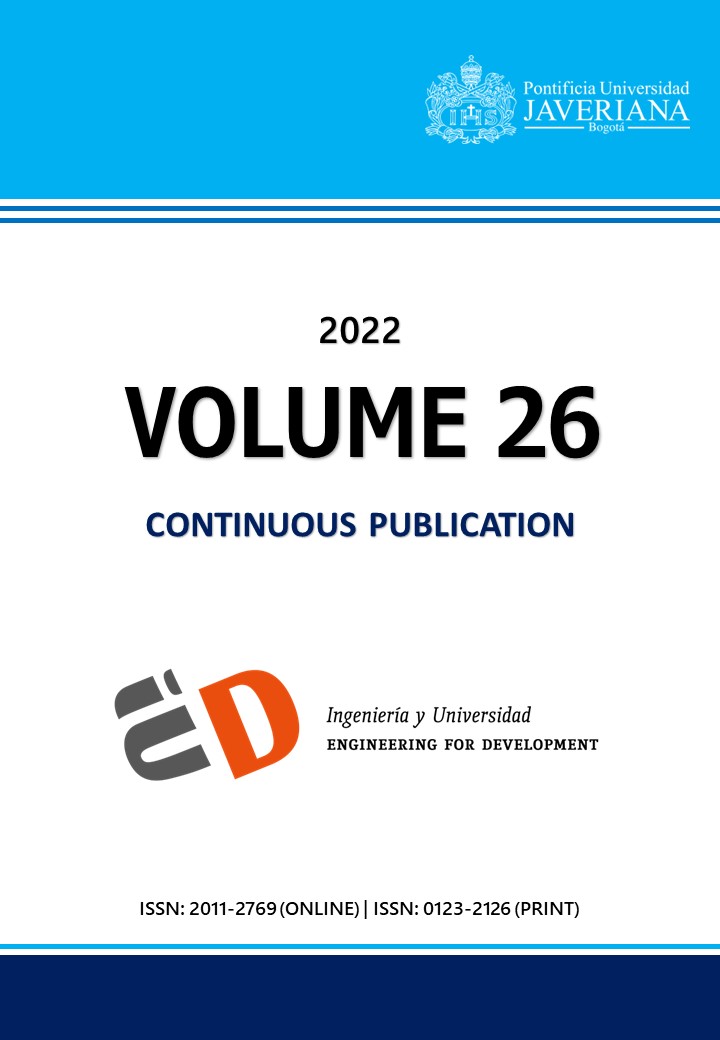Resumen
Dada la situación pandémica generada por el Covid-19, se es necesario replantear tanto el estilo de vida de la sociedad como su calidad de vida en torno al espacio público y urbano, pese a las cifras de la encuesta de movilidad 2019 de Bogotá, se registran en promedio una cifra de 14. 069 viajes a pie entre los 10 a 20 minutos según los patrones de viaje en las zonas de análisis de transporte distintivas en la unidad de planeamiento zonal en la ciudad de Bogotá Chapinero Centro. Esta UPZ a pesar de tener grandes dinámicas sociales y económicas, cuenta con andenes muy reducidos que dificultan el cumplimiento del distanciamiento social, necesario para mitigar la pandemia del Coronavirus. Por tal motivo, este artículo realizó un análisis geográfico de esta zona, mediante el uso de metadatos proporcionados por el mapa de vulnerabilidad de la web Coronavirus en Colombia del Departamento Nacional de Planeación, el Instituto de Evaluación Tecnológica en Salud y el Departamento Administrativo Nacional de Estadística. Este análisis geográfico permitió calcular las variables de indicador poblacional por manzana, la población máxima por andén y el criterio de cumplimiento del distanciamiento social. Estas variables permitieron diseñar los mapas de vulnerabilidad y distanciamiento social. Se evidenció que el 37% de los andenes no cumple con los 2 metros de distanciamiento entre personas, por lo cual se propuso ampliarlos en 3,5 metros y reducir este mismo valor en el espacio vehicular, para diseñar el mapa de distanciamiento social efectivo. Se concluye que la ampliación de los andenes permite hacer un uso flexible de las calles orientado a la sana distancia, lo cual podría ser complementado con un estudio de accesibilidad y un estudio de tráfico vehicular que midan el impacto de esta intervención.
Alcaldía local de Chapinero, “UPZ de la localidad de Chapinero”, 2020. Available: http://www.chapinero.gov.co/content/UPZ-la-localidad-chapineroJ. Zhang and N. Tansu, “Optical gain and laser characteristics of InGaN quantum wells on ternary InGaN substrates,” IEEE Photon. J., vol. 5, no. 2, Apr. 2013, Art no. 2600111.
Secretaría Distrital de Planeación, “Boletín estadístico Dinámica Empresarial de Bogotá IV trimestre de 2019”, 2020. Available: http://www.sdp.gov.co/system/tdf/repositorio-dice/dice201-dinamicaempresarial-31122019.pdf?file=1&type=node&id=22271&force=1
Secretaría Distrital de Planeación, “Diagnóstico de los principales aspectos territoriales, de infraestructura, demográficos y socioeconómicos: Chapinero 2017”, 2018. Available: http://www.sdp.gov.co/system/tdf/repositorio-dice/dice064-monografiachapinero-2017_vf.pdf?file=1&type=node&id=18966&force=1
Secretaría Distrital de Planeación, “Boletín estadístico número 5”, 2018. Available: http://www.sdp.gov.co/gestion-estudios-estrategicos/informacion-cartografia-y-estadistica/consulta?page=1
Robledo Restrepo, J. M., & Galarza Molina, D, “Movilidad sostenible en acción”, 2017.
NACTO, “Urban Street Design Guide”, 2013.
Coronavirus Colombia, “Mapa de Vulnerabilidad”, 2020. Available: https://coronaviruscolombia.gov.co/Covid19/estadisticas-covid-19/mapa-vulnerabilidad.html
D. DeCaprio, J. Gartner, T. Burgess, S. Kothari, S. Sayed, C. McCall, “Building a COVID-19 Vulnerability Index”, 2020. Available: https://doi.org/10.1101/2020.03.16.20036723
Programa de las Naciones Unidas para el Desarrollo (PNUD), “UNDP GRANDATA”, 2020. Available: https://covid.grandata.com/methodology
Secretaría Distrital de Movilidad, “Encuesta de movilidad”, 2019.
Departamento Administrativo Nacional de Estadística (DANE), “Nota metodológica del Índice de Vulnerabilidad por Manzana”, 2020. Available: https://www.dane.gov.co/files/comunicados/Nota_metodologica_indice_de_vulnerabilidad.pdf
Secretaria de Movilidad del Gobierno de la Ciudad de México, “Plan de apertura del Centro Histórico de la CDMX - hacia la nueva normalidad en el CH”, 2020. Available: https://semovi.cdmx.gob.mx/storage/app/media/200627_MovilidadJDG_NuevaMovilidadCH

Esta obra está bajo una licencia internacional Creative Commons Atribución 4.0.
Derechos de autor 2023 Juan Sebastián Sánchez-Gómez, MSc, Laura Alejandra Gutiérrez-Aguilar, BSc


